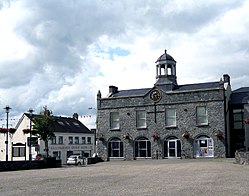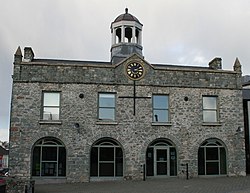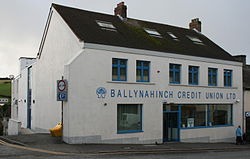Ballynahinch: Difference between revisions
Created page with '{{Infobox town |name=Ballynahinch |county=Down |picture=Ballynahinch Market House - geograph.jpg |picture caption=The Market House (middle) and Credit Union (left) |latitude=54.3…' |
|||
| Line 20: | Line 20: | ||
==History== | ==History== | ||
Ballynahinch was founded by Sir | Ballynahinch was founded by Sir George Rawdon in the 1600s and remained in the family's hands until 1798. | ||
In 1789 the Society of United Irishmen launched a rebellion. The United Irishmen had been founded in 1791 by liberal Protestants in Belfast and although its membership was mainly Catholic, many of its leaders and members in northeast Ulster were Protestant. The Battle of Ballynahinch began on 12 June 1798, when about 4000 United Irishmen camped at Ballynahinch were besieged by the British Army. The British bombarded the town with cannon for a full day until the United Irishmen retreated. Following this, the government soldiers burnt sixty-three houses in Ballynahinch and its hinterland. The commander of the United Irishmen, Henry Munro, was given up, captured and executed shortly after. | In 1789 the Society of United Irishmen launched a rebellion. The United Irishmen had been founded in 1791 by liberal Protestants in Belfast and although its membership was mainly Catholic, many of its leaders and members in northeast Ulster were Protestant. The Battle of Ballynahinch began on 12 June 1798, when about 4000 United Irishmen camped at Ballynahinch were besieged by the British Army. The British bombarded the town with cannon for a full day until the United Irishmen retreated. Following this, the government soldiers burnt sixty-three houses in Ballynahinch and its hinterland. The commander of the United Irishmen, Henry Munro, was given up, captured and executed shortly after. | ||
Latest revision as of 23:04, 31 March 2013
| Ballynahinch | |
| County Down | |
|---|---|
 The Market House (middle) and Credit Union (left) | |
| Location | |
| Location: | 54°23’42"N, 5°53’10"W |
| Data | |
| Population: | 5,364 (2001) |
| Post town: | Ballynahinch |
| Postcode: | BT24 |
| Dialling code: | 028 |
| Local Government | |
| Council: | Newry, Mourne and Down |
| Parliamentary constituency: |
South Down |
Ballynahinch is a market town in County Down.
The towns' function has been known for many years as a market town and a market still takes place in the square every Thursday. The town lies on the main A24 Belfast to Newcastle road 15 miles south of Belfast. Facilities in the town include a leisure centre. In recent years a regeneration committee has been formed for the development of the town and the surrounding Spa and Drumaness areas.
History
Ballynahinch was founded by Sir George Rawdon in the 1600s and remained in the family's hands until 1798.
In 1789 the Society of United Irishmen launched a rebellion. The United Irishmen had been founded in 1791 by liberal Protestants in Belfast and although its membership was mainly Catholic, many of its leaders and members in northeast Ulster were Protestant. The Battle of Ballynahinch began on 12 June 1798, when about 4000 United Irishmen camped at Ballynahinch were besieged by the British Army. The British bombarded the town with cannon for a full day until the United Irishmen retreated. Following this, the government soldiers burnt sixty-three houses in Ballynahinch and its hinterland. The commander of the United Irishmen, Henry Munro, was given up, captured and executed shortly after.



Buildings of note
- The town’s market house was built in 1795 and is currently used as a community centre
- An old flax mill and corn mill stand on the outskirts of the town.
Transport
Churches
- Edengrove Presbyterian Church, Dromore Road. Original church built in 1774, present church built in 1841.[1]
Big Society
Ballynahinch holds a loyalist flute band called 'Ballynahinch Protestant Boys' (BPB) which march at different locations across Northern Ireland.
Sport
- Rugby:
- Football:
- Ballynahinch Olympic
- Ballynahinch United
- Temple Rangers Football Club
- Hockey: Ballynahinch Hockey Club
Outside links
| ("Wikimedia Commons" has material about Ballynahinch) |
References
- ↑ "2nd and 3rd Presbyterian Church in Ballynahinch". Ros Davies' Co. Down. http://freepages.genealogy.rootsweb.ancestry.com/~rosdavies/PHOTOSwords/MagheradroolAll.htm#eden. Retrieved 23 November 2010.
